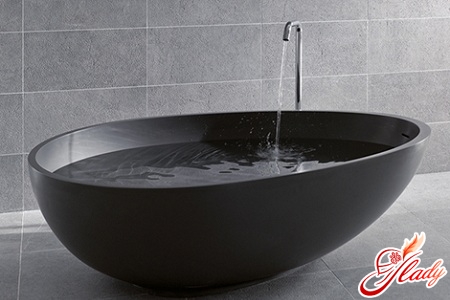 As we know, nothing lasts forever under the moon.Sooner or later, everything gets old, falls into disrepair and requires replacement or renovation. So, no matter how good a housewife you are, no matter how you keep your home clean and tidy, there comes a time when the bathtub becomes an eyesore. It loses its original pristine clean appearance and no tricks on your part can return the bathtub to its former beauty. That's when you are puzzled by the need to purchase new plumbing or look for an answer to the question of how to restore the enamel of the bathtub. So what to do? Buy a new one or restore the old one? Your bathtub requires replacement if it cannot be restored. Namely: its body is deformed, dents and cracks have appeared, the enamel has chipped off at the drain (or in other places). And another option when the bathtub should not be restored is simply "I want a new bathtub". Well, if you want it, then buy it. But remember that this procedure (replacing the bathtub) will require you to spend not only on the bathtub itself, but most likely also on pipes and tiles, which will definitely suffer during the replacement process. So, having decided to replace the bathtub, prepare yourself for a full renovation of the entire bathroom. But if the appearance of an “aged” bathtub simply offends your aesthetic taste, and the bathtub itself is still quite durable, then you can simply restore the darkened enamel that has lost its shine and smoothness. How to do this? There are two options: invite specialists or take on the job yourself. Yes, there is another option - use an acrylic liner, which is inserted directly into the bathtub. This is a fairly impact-resistant coating of various colors and shapes. However, it is almost impossible to install such a bathtub yourself, and it will not be cheap. So let's consider the first options for restoring bathtub enamel.
As we know, nothing lasts forever under the moon.Sooner or later, everything gets old, falls into disrepair and requires replacement or renovation. So, no matter how good a housewife you are, no matter how you keep your home clean and tidy, there comes a time when the bathtub becomes an eyesore. It loses its original pristine clean appearance and no tricks on your part can return the bathtub to its former beauty. That's when you are puzzled by the need to purchase new plumbing or look for an answer to the question of how to restore the enamel of the bathtub. So what to do? Buy a new one or restore the old one? Your bathtub requires replacement if it cannot be restored. Namely: its body is deformed, dents and cracks have appeared, the enamel has chipped off at the drain (or in other places). And another option when the bathtub should not be restored is simply "I want a new bathtub". Well, if you want it, then buy it. But remember that this procedure (replacing the bathtub) will require you to spend not only on the bathtub itself, but most likely also on pipes and tiles, which will definitely suffer during the replacement process. So, having decided to replace the bathtub, prepare yourself for a full renovation of the entire bathroom. But if the appearance of an “aged” bathtub simply offends your aesthetic taste, and the bathtub itself is still quite durable, then you can simply restore the darkened enamel that has lost its shine and smoothness. How to do this? There are two options: invite specialists or take on the job yourself. Yes, there is another option - use an acrylic liner, which is inserted directly into the bathtub. This is a fairly impact-resistant coating of various colors and shapes. However, it is almost impossible to install such a bathtub yourself, and it will not be cheap. So let's consider the first options for restoring bathtub enamel.
Work of professionals
Bath enamel restoration by specialists,Of course, this is a convenient option. Firstly, the cost of a restoration specialist's work does not exceed the cost of installing a new bathtub. Secondly, you will save yourself from additional physical work and save your time. Thirdly, if you cannot rely on your own strength, then you will not feel sorry for paying for the services of professionals. So look for the coordinates of specialists, call, order and enjoy the results of the work. However, in order for this joy to be complete and the quality of work excellent, listen to some advice.
If you think that it is not necessary to invite a specialist, and you are capable of restoring the enamel of the bathtub yourself, then choose the right time and get to work.
Recovering light enamel damage
If the enamel in your bathtub has retained its color and shineand smoothness, but there are small chips, you can try to restore only these damaged areas. To do this, take porcelain powder (for example, rub a porcelain cup or saucer), mix it with epoxy resin and carefully cover the chipped area. After drying, polish the restored area with zero sandpaper. Instead of porcelain powder, you can also use small pieces of porcelain or titanium white. They must be mixed in advance with "epoxy" (without hardener) and left for several days until the mass becomes homogeneous. Then mix the mass with the hardener, cover the chip, let the resin dry and level the surface of the "patch" with a blade. True, it will take about a week for the mixture to harden completely, during which time it will be impossible to use the bathtub. To restore small chips on a cast-iron bathtub, you need to clean the damaged area with sandpaper, degrease with gasoline and cover it with BF glue mixed with dry white. This mixture should be applied in several layers with an hour break. The number of layers is determined by the thickness of the enamel: apply them until the glue is level with the enamel layer. Another way is to use white nitro enamel and Supercement glue. Mix the same amount (in grams) of components, degrease the restoration site with gasoline and cover with the mixture. It will take a day for such a mixture to dry, and if necessary, this procedure can be repeated only after twenty-four hours. Well, if there are no chips, but the enamel has become rough and porous (this happens with cast-iron bathtubs), then restore it with white nitro enamel. To do this, degrease the entire bathtub with acetone, pour a little paint into it and thoroughly rub the nitro enamel into the surface: this way you will fill all the cracks and pores on the "aged" enamel. Repeat the procedure several times, removing excess paint with acetone soaked in solvent. For an even application of the final layer, it is better to use spray paint.
Restoration of enamel at home
The work seems difficult only at first glance.In fact, it is quite simple, although labor-intensive and does not take much time (about five hours). To completely restore the enamel of the bathtub on your own, you need to:
- it is good to clean the entire inner surface of the bath from the old enamel with any cleaning powder without bleach and an abrasive stone: apply a powder, clean with an abrasive, wash off the crumbled enamel;
- clean out any irregularities and rust;
- degrease the entire surface of the bath with acetone, gasoline or other solvent;
- flush the solvent by filling the bath with hot water for ten minutes;
- wipe dry with any hygroscopic lint-free cloth or blow dry;
- mix enamel with hardener;
- apply the first layer of enamel (or primer) and allow it to dry completely;
- cover the bath with a second "front" layer of enamel, making sure that no bubbles and streaks form.
That's all, actually.In general, each enamel comes with instructions for use indicating the proportions of mixing ingredients, the required number of layers, drying time and service life. But in order for the restored enamel to last as long as possible, it is necessary to follow some rules.
Care of the restored bathroom
If you follow the rules for caring for your bathtub,restored enamel, it will serve you for at least five years. In order not to shorten this period, in no case should you use products containing chlorine or abrasive powders to wash the bathtub. It is also not recommended to soak laundry in it or drain water from the washing machine if you use bleaches for washing. It is best to clean and wash the restored bathtub with dishwashing detergents, using a sponge or a soft cloth for this. In a word, after you have managed to restore the enamel in the bathtub (on your own or with the help of a master), do not use any aggressive products to care for it. If it is a liquid product, then it should be acid-free and chlorine-free, if powder, then without abrasives. And then for at least another five years your aesthetic and household ideals will not suffer from the unsightly state of the bathtub, and bathing in it will be “solid pleasure”.









